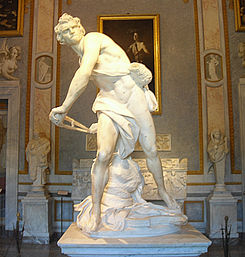Blue Boy by Thomas Gainsborough (c1748-1750) was an amazing painting in the 18th century. The oil painting was actually a previous painting but was painted over with the “blue boy”. What makes this piece so unique is that it is so different from a Renaissance oil painting. There is more focus on the full figure rather then what surrounds the figure. The background is purposely blurry which has never been seen before, which is an interesting painting technique. It’s interesting that Gainsborough decided to make the background blurry because he’s actually a landscape painter. Most of his work has landscape painted within them, along with formal suitable figures.
Gainsborough had seen sent to London when he was 13 to pursue learning about landscape when he started learning of the French Rococo, which has a major influence on his paintings and the growth of his style. He was specifically known for painting and drawing such detailed landscape variety, it made him quite famous and well known for his love of landscapes. Other painters thought he was the most keen into spending so much time on just his landscapes. “Blue Boy” was supposed to be a completely different painting then it turned out to be, but it also turned out to be one of Gainsborough’s most well known paintings. It is said the Gainsborough painted the “Blue Boy” just to prove his rival, Joshua Reynolds and his philosophy on painting. His influences included Anthony Van Dyck and his wonderful dedicated lifestyle to painting new things. He liked to paint things that Van Dyck used in his paintings or were similar. The clothes that Van Dyck painted in his pictures had an influence on Gainsborough as well. He liked to paint people from all sorts of classes and it is common that most painters, including Allan Ramsay and Joshua Reynolds also were somewhat devoted to represent sitters in their paintings.
“Blue Boy” is unique in it’s own way. It is said that he painted such a character with these specific clothes because it was in a different century. The painting itself is very different then any Renaissance picture I’ve seen. The character is different, the background style is different and also the colors are very contrasting. My favorite part of this painting is that the “Blue Boy” seems sophisticated, like he’s waiting for something. The colors of his attire are completely opposite to the background and that’s very original for Gainsborough to do. I wish I knew why he decided to paint such a beautiful landscape, then all of the sudden paint over it with such a random subject, a boy in all blue. Other historians believe that his influence directly came from Van Dyck and Rococo. His love for landscape made him famous. Not only did he paint beautiful figures but with such a unique style of backgrounds.
"Thomas Gainsborough." . N.p., n.d. Web. 29 Feb 2012. <http://www.wga.hu/tours/english/frame4.html>.
The Blue Boy (c 1770). "Thomas Gainsborough." . N.p., n.d. Web. 29 Feb 2012. < http://huntington.org/thehuntington_full.aspx?id=982 >.
David A. Brenneman, . "Thomas Gainsborough and the "thin brilliant style of pencilling Van Dyck"." . N.p., n.d. Web. 29 Feb 2012.<http://www.jstor.org/pss/10.1525/hlq.2007.70.2.203?searchUrl=/action/doBasicSearch?Query=Thomas+Gainsborough&acc=off&wc=on&Search=yes>.





